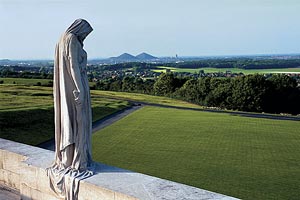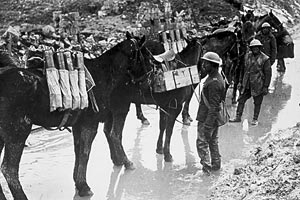
The Courage to Teach in Afghanistan
Though schools are open, death threats persist.
by Sally Armstrong
Transition to Teaching 2006: The best and worst of times
by Frank McIntyre and Brian Jamieson
Transition to Teaching 2006: Help for new teachers slow in coming
by Frank McIntyre and Brian Jamieson
Living the Standards
by Lois Browne
Vimy Revisited
Port Perry teacher Dave Robinson co-ordinates teachers and more than 3,600 students on this trip to the historic ridge.
by Leanne Miller
Vimy RevisitedEvery year history teachers strive to help another crop of 15-year-olds understand the social and political circumstances that led young Canadians, not much older than themselves, into the so-called war to end all wars, in which over 66,000 were killed and 173,000 wounded “for God and Empire.”One solution is what Port Perry High School teacher Dave Robinson calls experiential education.by Leanne Miller |
Some have called the battle there the birth of our nation. Dave Robinson hopes that 90 years later Vimy Ridge will give birth to deep and lasting understanding among his students.
As head of the Canada and World Studies department at Port Perry High School in the Durham DSB, Robinson has taught the compulsory 20th-century Canadian history course at least once a year for as long as he can remember. He has loved every minute of it and his enthusiasm and commitment remain strong.
Robinson believes the key to engaging students is in offering them authentic experiences that have consequences. He found this key years ago when he helped design a program in which students at risk ran a storefront classroom. He charged the students with organizing Port Perry's Santa Claus parade.
“They had to raise sponsors, book marching bands and get community floats – or face the very real consequence of disappointing thousands of children along an empty parade route. It was those consequences and the students' efforts that reinforced their textbook learning.” The parade was a great success and Robinson and his students – in academic and applied programs, including those at risk – have never looked back.
Using computer simulation, today's students can role-play any historical battle they wish. And through popular mainstream films and television – Saving Private Ryan and Band of Brothers, for instance – they may have strong impressions of the brutality and sacrifices of war.
Nevertheless, Robinson has found that a more personal and Canadian perspective is important. “They know their grandfathers and great-grandfathers fought in the wars, and many want to share in this emotional commitment from their family history.”
He offers students an opportunity to gain personal perspective: walking over no man's land and through the trenches, visiting the World War I cemeteries in France and Belgium and actually climbing Vimy Ridge.
This April, Robinson will lead a Canadian contingent of as many as 3,600 secondary students, 200 parents, a pipe band and 360 adult supervisors on a pilgrimage to England, Belgium and France. There they will retrace the steps of Canadian soldiers during World War I and take part in commemoration ceremonies for the 90th anniversary of the Battle of Vimy Ridge.
This battle has particular significance for Canadians as forces from across the country united, meticulously planned and – under senior Canadian leadership for the first time – succeeded where other Allied forces had failed: storming the ridge to conquer the long-held German stronghold.
The costly victory, with nearly 3,600 killed and over 7,000 wounded in four days of fighting, prompted Canadian brigadier general A.E. Ross to declare, “In those few minutes I witnessed the birth of a nation.”
 |
“More than 3,600 students will be present for the rededication ceremony.” |
The Vimy Memorial rises high atop the ridge where Canadians fought. Its topmost figure – representing peace – towers 110 metres above the plain below. Inscribed on the walls are the names of 11,285 Canadian soldiers killed in France during the war, whose final resting places are unknown.
The monument is currently undergoing a $20-million refurbishment, and a rededication ceremony on April 9, 2007 will be televised nationally. Scheduled dignitaries for the ceremony include Queen Elizabeth, the prime ministers of Canada and England and the president of France. More than 3,600 students will be present for the rededication ceremony – most of them part of a nationally co-ordinated trip by Robinson. Students travelling as part of this tour will play a special role, with most of them wearing replica Canadian army shirts, each with the name of a soldier killed in the battle.
The number of students is significant. During the fall 2006 semester each student participant researched and recorded the personal story of one of the nearly 3,600 Canadian soldiers killed in the battle. Robinson's colleague Nancy Hamer Strahl assigned the name of one of the soldiers killed to each student for research – wherever possible, a relative.
Students submitted their work in a variety of media as a regular history assignment. Hard copies of written work and a CD archiving digital work – stories, images, sound and film – will be sealed in a capsule. The works will also be on display at Vimy's education centre.
Other trip highlights include a tour of London, a Chunnel crossing, visits to Dieppe and the Normandy beaches, a visit to Belgium to see Flanders Fields and attend the Last Post ceremony at the Menin Gate in Ypres and a visit to Paris.
“I think this trip will bring to life what we read.”
Students from most of Durham's 20 secondary schools will participate, as well as some from the neighbouring Kawartha Pine Ridge DSB and others from across Ontario.
Julian Hall, a teacher at St. Mark High School in Manotick, is co-ordinating the trip for all 14 of the Ottawa-Carleton Catholic DSB's secondary schools. He estimates that 300 students and up to 40 teachers will participate.
In addition, students and teachers from British Columbia, Alberta, Manitoba, Québec, Nova Scotia, Newfoundland, the Yukon and the Northwest Territories will attend.
Michael Barrett, chair of the Durham DSB, will join the trip along with his 17-year-old daughter Meagan. “The logistics for a trip of this magnitude are immense and the attention to detail is evident in Dave's meticulous planning and organization,” says Barrett. “It is not unlike co-ordinating our volunteer soldiers in 1914 and 1915 from small towns across Canada.”
Barrett also has a personal connection with the trip. His great-grandfather Alfred Barrett fought at Vimy and survived, only to be killed in action in August of 1918. “This trip will also be a personal journey for Meagan and me,” he explains. “Although I have already visited Vimy and laid flowers at my great-grandfather's grave, she has never been.”
Barrett is enthusiastic about the impact of Robinson's work. “Students and parents are fortunate to have such a visionary in the school system. This trip reflects the efforts of a dedicated team of teachers and fulfills the dream of a man who wants our students – our children – to know that history is not words in a book but a living part of our own experience today.”
Janice Gilmour, her husband Michael and their three children will be going.
“I'm not sure what to expect,” she admits. “I didn't learn much about World War I when I was in school and I had never heard of Vimy. But my daughter Kirsten is studying it now with Ms. Hamer Strahl and she comes home and talks about the horrors of life in the trenches for these brave young Canadians. It's fascinating. I think Remembrance Day will never be the same for any of us after we visit Vimy.”
Leslie McGuiness learned about Vimy last year when she was in Grade 10. “I think this trip will bring to life what we read and I'm sure it will be fantastic.”
 |
“Robinson's colleague Nancy Hamer Strahl assigned the name of one soldier killed to each student for research.” |
Robinson strongly believes that all students – not just those who can afford it – should have the opportunity to travel abroad, and he puts just as much effort into fundraising as he does into planning his excursions. The cost of the tour is $3,416 for students and $3,749 for adults.
Since April of 2006 Robinson has been sending out semi-monthly e-mail updates on recruiting and fundraising – complete with pictures and historical facts designed to inform and generate interest. He estimates that 10,000 people across the country read them.
Like many participating teachers he has been co-ordinating local fundraising events and organizing monthly lectures. “Through the kindness and generosity of some of Canada's finest writers, researchers and veterans, we are able to put on fantastic history evenings,” he boasts.
One of the ways Julian Hall and his St. Mark students fundraised was through a symbolic Walk to Vimy held on Remembrance Day 2006. All student travellers collected sponsorship money and walked from Manotick to the Canadian War Museum in Ottawa to honour veterans. “We worked with the local legion to involve veterans. The students raised money and awareness for the trip and they got to tour the museum,” Hall explains. “The excitement is building.”
This April all the hard work will come to fruition as students from across the country experience the school trip of a lifetime. Here's betting they return with personal insights into the significance of what happened there 90 years ago.
The countdown for Vimy 2007 is on. But Robinson is planning other trips before his scheduled retirement in June 2009. Hands across the Generations – Remembrance in Korea and Japan is in the works for 2008.
While the group Robinson is leading is the largest, there are many student trips to Vimy planned for this spring and several companies offer package tours for students and teachers.
Historical images of the Vimy Monument and the Battle of Vimy Ridge reproduced with the permission of Veterans Affairs Canada, 2006.
National fundraising
Fundraising for this ambitious trip has included a year-long, country-wide corporate campaign as well as the local campaigns that teachers know well.
Robinson has been keen to secure corporate funding for important things beyond the cost of travel and accommodation.
“Addressing our concerns for security and ensuring that our students represent our country's youth,” he is raising money for seasonal jackets and hats that will identify the students who are part of the trip.
“We want to show that we are Canadians who are proud of our country's distinguished military history.”
He aims to have a laptop donated for each busload of students so they can post daily pictures of the tour to their web site. He also plans to secure international cell phones and long-distance air time so that families and classmates back home can share in the students' experiences.
The Durham DSB's director Craig Burch admires what Robinson is doing. “Dave's fundraising and trip-planning efforts go way beyond the work of a normal teacher. He is committed to ensuring that kids who can't afford these kinds of life experiences can participate.”
The national campaign includes a World War I memorabilia raffle, a walkathon, a skateathon, a massive yard sale held at several schools, a community-challenge car wash in Port Perry, semi-monthly historical guest lectures, theatre, a gala dinner and more.
Robinson also co-ordinated the donation and auction of a motorcycle called Birth of a Nation. The donation was made by Cranked Customs in Port Perry (www.crankedcustoms.com). The chopper, valued at more than $40,000, is custom-designed with scenes of the Vimy Memorial and the Battle of Vimy Ridge and augmented with World War I medals. It will be auctioned on eBay starting mid-January and closing around the beginning of March.
 |
|
The Giant Community Car Wash Challenge in Port Perry in September was one of dozens of local and many national fundraising activities to help cover the special costs of the trip. |





